Part Four: Looking out
Project: From inside looking out
Exercise: View from window or doorway
This exercise was very tricky for me to do as I have a very low viewpoint from my windows. The windows are very old sash windows located really low near the ground. I can only see the view while sitting down so I don’t have too much close up landscape views more things a little further away. I have painted the corner of Bolton Hall and some trees. Depending on the time of day the lighting is very strong and I can’t normally see both the window and what is outside. I have done two acrylic painting on A3 format. I used some of the inside of the room like the top of the sofa. I did these very quickly as the lighting changed quickly and this made the task difficult.
Exercise: Hard or Soft Landscape
For this exercise after the difficulties with the last exercises I decided to work from a different part of the house where the view is facing the north and the lighting is more stable and easier to work with. I decided to paint the stables that are attached to my house as I always wanted to paint them. I had a lot of time to work on this painting. I did a 91×91 oil painting. I’m not sure I did the whole composition right because I tried to capture it in a certain perspective but also couldn’t help myself painting the horses without which the stables would feel empty. I try giving impression of the stone wall and giving the wooden and metal structures to the painting.
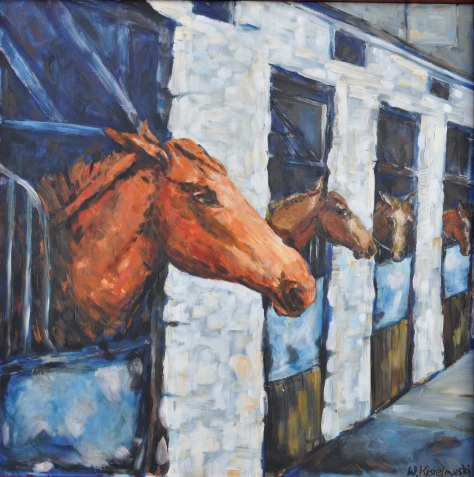
Project: Perspective
Exercise: Linear Perspective
For this exercise I chose to work with oils on canvas in landscape format 100×80. I worked from photograph I took from where I walk my dog everyday as I live in the Yorkshire dales. The photograph was only the guide to the painting as the landscape is one I know very well and observe regularly. I think this type of landscape is perfect to create a form of linear perspective. On one side of the river there is lots of dry stone walls which give perspective on the other there is barbed wire fencing, the river getting smaller higher up also gives a good perspective.

Exercise: Aerial Perspective
For this exercise I found photos from a calendar from the Lake District. I found an interesting aerial perspective in the photograph. There is a certain depth where there are mountains in the background, trees in the forefront and an interesting middle part showing houses in a valley. I painted this oil on board 55×46. When I looked at it after a certain time I decided I was not happy with the effect it gives, you can’t see too much difference between the forefront and the background and everything seems very flat, it lacks space.
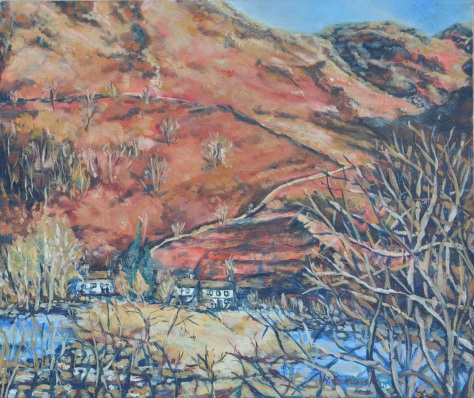
Project: Expressive Landscape
Exercise: Creating Mood and Atmosphere
For this exercise I chose work from a photograph from a postcard showing the house of parliament in London. I worked oil on canvas in an A3 format. This was an interesting experience as I wanted to do something more precise and different. I needed to draw an identical landscape and had to square up and then draw on the canvas from the postcard. I don’t have a tendency to paint too many details, I always use a wider brush, but I wanted to create an atmosphere and experimented. I painted all the details like I always do but using turpentine so the paint dried really quick and after a few days and diluted some yellow and while paint with oil and I covered all the paint with a second layer so the previous layer mixed slightly with the second layer and the whole painting became more one, and an atmosphere was created. Next I wanted to do something different and I decided to paint on a 80×60 canvas with acrylic where the concept for the painting came about by chance when one early morning on the way to work where I walk past a small woodland area. When I put the outside light on or when it is a full moon, I always admire how the trees which normally have their own colour seem to shine and have a whiter colour in the unusual light. I was always fascinated by this so I tried to paint this creating a similar effect; I think the painting definitely has some atmosphere and mystery.
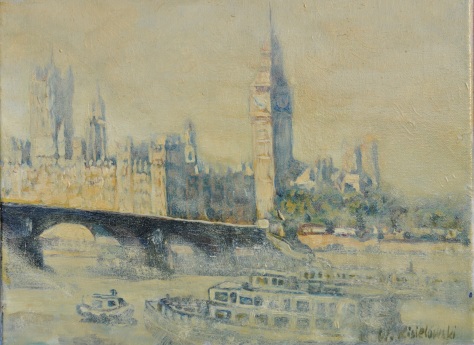

Project: Painting Outside
Exercise: Painting a Landscape Outside
I have had a lot of experience with painting outside, where I live is a private estate and a large far so I have a lot of privacy. I have done a lot of work outside during my watercolour and drawing course outside. The only challenge is the weather and my time. I made a few A3 paintings looking for interesting spots, like I said earlier there is plenty of dry stone walls, barns and green fields around. I also tried to work very quickly as the sky changed quickly as did the lighting. I sometimes had to work with great contrast when the forefront was light but the background was dark due to a dark cloud or it simply getting darker. I tried experiment on different grounds doing one on purple paper as I had one prepared. I just tried to do a quick sketch of the landscape not focusing on the colour just the distances between objects and the space itself. The next day I reserved the whole day to do an oil on canvas 91×91, where the view is amazing on top of a cliff looking through trees onto a hilly landscape. I tried to show a truly autumnal atmosphere.
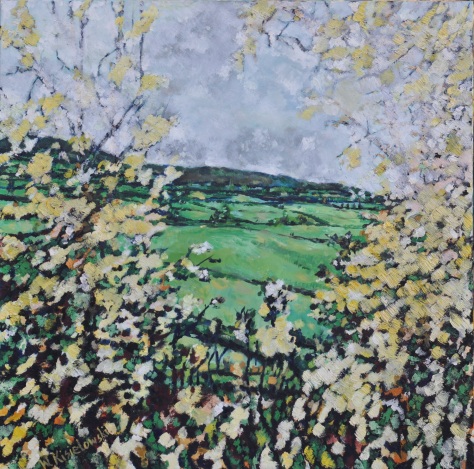
Project: Working from drawings and photographs
Part of theses exercise I have done during the earlier ones for example I needed to square up while doing the house of parliament painting. What I can say is working from a photograph is that I like using my own photographs because I can then alter it and crop and can create the composition I want as I know where the photo was talked and what I’m trying to achieve. I have great opportunity to play with landscape, the only thing I found is that sometimes these things don’t line up with the exercises and I have to go back and redo certain things or do things in a different way to how I would like to do them. I always try to use my sketchbook or previous work not only from this course but also from the watercolour and drawing courses, which means that if I have a problem with a certain element I can look back and see how I could possibly fix this problem. There are a lot of similarities between the courses but they are not joined so I have to do the same thing again just to fill an exercise. So I used a photograph and doing a painting oil on board 55×46 this is a painting from a calendar from the lake district, I had lots of photographs and looking through them couldn’t decide and my wife suggested this photo and I decided it was appropriate.
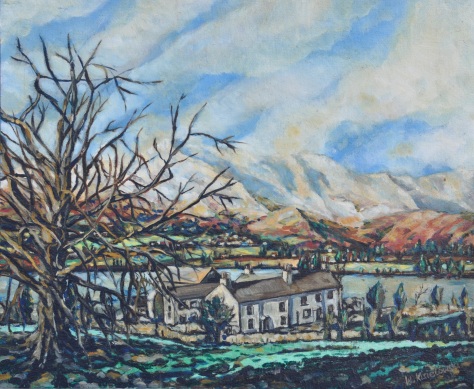
During all exercise, I used different medium like oil, acrylic and tempera and on different bases such as paper and canvas. I find it more exciting to work with oil because I have more time for it to dry so I can add pigment of colour dilute it easier on canvas. Acrylic is quick dry paint and I need to work faster and different using it. I always like having a lot of paint on the canvas using less oil or water to dilute it, I work differently to when I use watercolour where there is more transparency. I think that oil or acrylic painting shouldn’t resemble watercolour, so I always try avoiding using transparent layers on my canvas. In my opinion different medium requires different techniques. When I paint I always have a problem of how to use the different medium to achieve how I am feeling and my own kind of expression.
I also created a surrealistic landscape using oil on a board. When I studied Max Ernst works I liked to try to do something like him .
Oil on board 98×60 cm
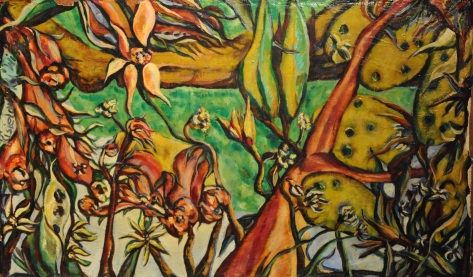
Oil on board 65X45 cm
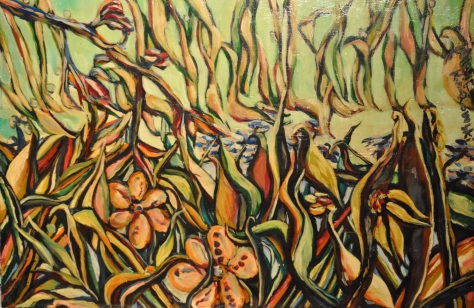
I also looked into the golden ratio and have found that it is more a mathematical concept that appears in nature and in art. I think a lot of the art that is shown to have the golden ratio is done subconsciously and appears to have a golden ratio because it is in a way a natural form of beauty and proportions. I have also looked into the rule of thirds which I feel like is more useful and more doable. I feel like it helps with showing a balanced composition and helps create a more satisfactory composition helping with placement of horizon and main focus. I think this is helpful if you are unsure of the composition or where to start or when you are cropping a picture to get the best viewpoint.


















